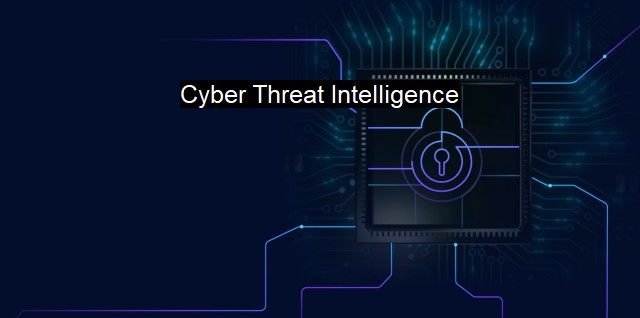What is Cyber Threat Intelligence?
Understanding Cyber Threat Intelligence in Cybersecurity and Antivirus: Identifying, Analyzing, and Mitigating Potential Threats to Organizations and Individuals
Cyber threat intelligence is a core facet of cybersecurity practices that sandwiches between preventive measures and reactive responses. it involves the analysis and interpretation of data related to potential cyber threats such as malware, viruses, ransomware, phishing, and Advanced Persistent Threats among others. It is the process of collecting information about these threats, analyzing past behaviors, and predicting future activities to enhance the security of an organization's cyber infrastructure.Cyber threat intelligence goes beyond the traditional approach of responding to cyber incidents after they occur. It helps organizations anticipate cyber threats before they strike, empowering them to harden their defenses, take proactive steps to bolster their protection mechanisms, and put proper measures robust enough to ward off sophisticated attacks from vulnerabilities.
The rapid growth of technology comes in tandem with the proliferation of cyber threats. As a result, organizations have sought to invest heavily in cybersecurity efforts to maintain the confidentiality, integrity, and availability of their information systems. The arena of establishing the toolkits that to circumnavigate or neutralize the impact of a potential attack hence depends on the cyber threats one can envisage— this art and science of anticipating the threats is what substantiates cyber threat intelligence.
Cyber threat intelligence takes several forms and is broken down into strategic, operational, and tactical intelligence.
Strategic cyber threat intelligence presents a broad picture of cyber threats. It explores how cyber threats can affect the long-term objectives of an organization. It combines data from several sources, identifies trends, and determines the most likely threats an organization can face.
Operational cyber threat intelligence zeroes in on the tactics, techniques, and procedures (TTP) employed by hackers. It involves exploring past incidents, the analysis of malware and other forms of attacks, and the prediction of likely evolutions of these threats.
On the other hand, tactical cyber threat intelligence focuses on the daily activities that can fortify an organization’s defenses. It involves real-time analysis of existing threats and advice to the IT security team on the measures to take. It typically involves scanning system logs, analyzing incidents, and scrutinizing network traffic.
Through cyber threat intelligence, organizations can gain an in-depth understanding of the threats facing them. A clear understanding of these threats helps them design effective security measures to tackle real threats as opposed to conjectural ones.
In the world of antivirus, the utility of cyber threat intelligence is profound. Antivirus software leverages cyber threat intelligence as it deals with known threats, protects against potential threats, and ensures the overall security of a system. In the landscape where cybersecurity threats constantly evolve, cyber threat intelligence helps to identify these mutations and swiftly adapt to protect systems.
While the usual functionality of an antivirus is predicated on a repository of known viruses and malware samples, threat intelligence informs updates to these repositories making the protective layer of an antivirus adaptive to new threat morphologies.
The importance of cyber threat intelligence has grown substantially in the wake of increasing digital interconnectivity. This underlines the need for industries, governments, and organizations to adopt and foster a culture of proactive rather than reactive cybersecurity. Knowing what you are up against better equips the armor you would wrap your systems and infrastructure around— from a philosophical standpoint, cyber threat intelligence is the epitome of the adage, "forewarned is forearmed."
Cyber threat intelligence is inextricably linked to antivirus software in its enactment in providing preventative, protective, and efficient responses to cyber threats. It remains indispensable in providing a security buffer for organizations and contributing towards sterile cyberspace with strength and solid infrastructure to carry on with activities as may be required in a technologically driven age.

Cyber Threat Intelligence FAQs
What is Cyber Threat Intelligence?
Cyber Threat Intelligence (CTI) refers to the process of collecting and analyzing data about potential cybersecurity threats and incidents to gain insights into the tactics, techniques, and procedures (TTPs) used by threat actors.Why is Cyber Threat Intelligence important?
Cyber Threat Intelligence helps organizations identify, assess, and mitigate potential cyber threats and vulnerabilities. By analyzing threat data, organizations can better understand the motives, capabilities, and intentions of threat actors, which can inform the development of effective cybersecurity strategies.What are the benefits of using Cyber Threat Intelligence?
The benefits of Cyber Threat Intelligence include improved situational awareness, better threat detection and response, enhanced incident management, and reduced risk and exposure to cyber threats. It can also help improve regulatory compliance and provide valuable insights to inform strategic decision-making.What types of data are included in Cyber Threat Intelligence?
Cyber Threat Intelligence data can include information such as malware signatures, IP addresses, domain names, email addresses, indicators of compromise (IOCs), and threat actor profiles. It can also involve analysis of technical data such as packet captures, system logs, and other network activity data.| | A | | | B | | | C | | | D | | | E | | | F | | | G | | | H | | | I | | | J | | | K | | | L | | | M | |
| | N | | | O | | | P | | | Q | | | R | | | S | | | T | | | U | | | V | | | W | | | X | | | Y | | | Z | |
| | 1 | | | 2 | | | 3 | | | 4 | | | 7 | | | 8 | | |||||||